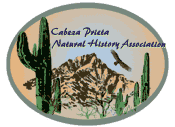
Cabeza Prieta Natural History Association
Sonoran Desert Reptiles
Chionactis occipitalis (Western shovelnose snake)

|
Diet: insects (including larval stages), spiders, scorpions, centipedes, buried chysalids (pupae) of moths
Size: 10" to 17" |
A dark- and light-banded snake with a shovel-shaped snout, flatter than in most other snakes; lower jaw deeply inset (countersunk) and nasal valves well developed. Belly concaved. Head slightly widier than neck. Dark brown or black crossbands, usually 21 or more, on body, are saddle-like or encircle body. Ground color is whitish or yellow. Dorsal scales smooth, usually in 15 rows at midbody. Internasals not separated by rostral. Anal divided.
Burrowing, nocturnal. Smooth scales, inset lower jaw, nasal valves, and angular abdomen are adaptations for "sand swimming" - wiggling through sand rather than tunneling in it.
References
|
Photo Credits:
Photo #1
Copyright Creative Commons
HTML & Programing by
Thomas R. Powell